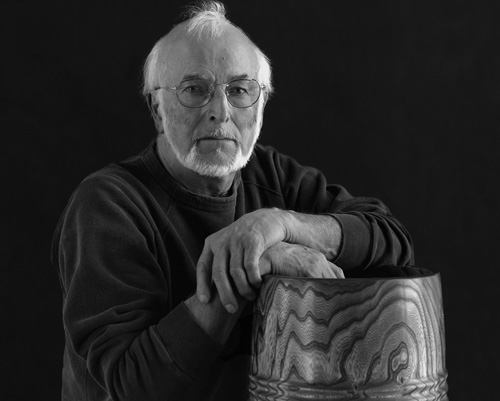
Portrait of Gordon Dunphy, Strathbutler 2002(photo – James Wilson)
… the “wood spoke to him” and his art, in turn spoke to many …
Gordon Dunphy was born into an old New Brunswick farm family on the Nashwaak river Valley. He spent the greater part of his life as a highly respected dairy farmer, specializing in animal husbandry. Dunphy never received formal training, but set himself up in a studio in Taymouth, N.B. He soon developed a reputation for creating eloquent turned wood pieces that showed off distinct characteristics of the original material. No one expected him to do anything else until the day in 1981 when he turned from farming to embrace his own art, imagination and poetry in his pursuit of wood turning. He soon received invitations to show his work throughout Canada and Europe, becoming an internationally recognized and renowned master craftsman.
Gordon Dunphy’s respect for his material allowed him to transcend his own craft. He neither regarded wood as a medium for his message nor as a vehicle for his virtuoso turning techniques. Rather, the wood was a once living substance, a subject worthy of his collaboration. When describing his work, Gordon always stated that the “wood spoke to him” and his art, in turn spoke to many.
- A Gallery of Gordon Dunphy’s work
- CBC article on his life
- For all posts on Gordon Dunphy
Gordon Dunphy’s contribution to New Brunswick’s cultural landscape was marked by numerous awards. In 1988 and 1980 he received the New Brunswick Crafts Council Premier’s Prize, in 1995 the Kjeld and Erica Dykeman Award for Excellence in Craft and in 2002 he received the prestigious Strathbutler Award for Excellance in Fine Craft and Visual Arts. After a battle with cancer, Dunphy died at the age of 74.
Dunphy’s work can be found in many private, corporate and public collections including that of the British Royal Family.
In the artist’s words
Art? – My mid-life crisis maybe, that time in your 40s. I was a dairy farmer, and I wanted to do something else … Friends took me to craft shows, and for the first time I met artists, and I got really, really interested and I decided to make the change. (From an interview CBC from his home in the Nashwaak River Valley)
This is what’s important to try to catch — that spirit that trees have, especially big old hardwood trees, and if I can catch that and make it look simple, the best forms are those that look as if they just happened …
On Burls
When the cells start to grow faster than the tree itself, and it .. usually a protruding growth on the tree itself. And often, not always, but often, it’s a beautiful grain in colour.
